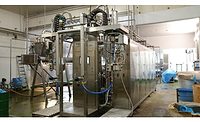Sustainable Solution for Low-Acid Aseptic Filling

Low-acid aseptic filling is the process of bringing together a commercially sterile product with a commercially sterile package in a sterile environment. The finished product does not require refrigeration and will have a longer shelf life, typically greater than 90 days and up to 2 years.
The renewed interest in aseptic filling is driven by a need for more sustainable processes and packaging, plus the growth of more sensitive, healthy and "cross-over" beverage and food products. The benefits of aseptic filling include the use of high-speed fillers for more throughput and shorter sterilization times; lighter weight, more sustainable packaging; lower running temperatures that provide energy savings and more packaging flexibility. In addition, shelf-stable products do not require a cold supply chain, providing food processors with significant energy savings.
Historically in the U.S., hydrogen peroxide was the only chemical sterilant that could be used to sterilize packaging material for shelf-stable, low-acid foods. Other traditional, non-chemical means of producing shelf-stable, low-acid foods are hot-fill and canning. The drawback to these traditional methods of sterilization is that the packaging material must be able to withstand very high temperatures (>212 °F) and/or pressures. As food processors switch to lighter weight packaging material such as PET (polyethylene terephthalate), a new method to sterilize the packaging material is required. Since low-acid, shelf-stable foods are regulated by the FDA, this method of sterilization must meet the low-acid canned food regulation in 21 CFR 108, 113 and 114.
Improved Performance
In the past, food processors in the U.S. were limited to traditional means (hot-fill or retort) of package sterilization. Today, food processors are allowed to define the performance requirements necessary to produce shelf-stable, low-acid foods, allowing chemical sterilants such as peroxyacetic acid (POAA) to be used to sterilize packaging material prior to filling. The benefit of using POAA to sterilize packaging material is that it can be applied at much lower temperatures. For example, POAA can be used to sterilize packaging material at 60 °C. This lower application temperature allows the food processor to switch to light-weight packaging material and provide energy savings.
In order for food processors in the U.S. to realize these benefits of aseptic filling, significant regulatory hurdles had to be overcome. The Enviro San® commercial sterilant was registered as an antimicrobial with the U.S. EPA Antimicrobial Division, and an effective food contact notification was filed and approved by the FDA as an indirect food additive. The low-acid aseptic equipment was validated and filed with the FDA using the EPA-registered commercial sterilant.
This process is outlined in 21 CFR 108, 113 and 114 and requires that the commercial sterilant is tested on an aseptic filler to ensure that the entire process of making the finished product is adequate to produce commercially sterile food. To complete this portion of the project, it is necessary to show that the EPA-registered commercial sterilant can be used to effectively bring the filling equipment and packaging material to a commercially sterile state. This complex regulatory validation process requires knowledgeable and experienced partners.
As the first POAA-based sterilant system to receive an FDA Letter of Non-Objection on a high-speed, low-acid rotary filler using PET bottles, Enviro San® is a patented, 15% POAA product and ES-1000™ is an adjuvant that is dosed into the POAA to enhance the contact of the POAA with the bacterial spores. This sterilant system results in achievable levels of food safety and brand protection and is the first and only sterilant registered with the EPA for use against Bacillus cereus, the most resistant known pathogen for POAA-based sterilants. This combination system is also registered with the EPA as a commercial sterilant for use against B. subtilis and Clostridium sporogenes.
With FDA clearance and EPA registration for use on non-porous packaging types, including PET and HDPE, and most food products, Enviro San® can be used to sterilize packaging material and equipment. The complete system can be used at significantly lower operating temperatures, providing energy savings. Its use not only offers reduced energy costs associated with heating, but also mitigates PET bottle shrinkage and peroxide residuals.
This described low-acid aseptic sterilant technology is currently in use at several major U.S. food-processing facilities. If you are considering aseptic filling for a new product or to upgrade your current packaging process, use of this system for commercial sterilization of food packaging and equipment, combined with the company’s expertise and understanding of regulatory requirements and process validation, can provide food and brand protection while maximizing operational performance and sustainability.
>
Looking for a reprint of this article?
From high-res PDFs to custom plaques, order your copy today!








